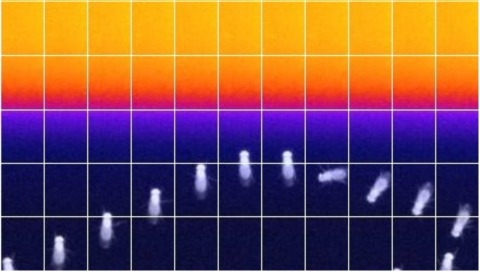Filter
Associated Lab
- Aso Lab (1) Apply Aso Lab filter
- Branson Lab (4) Apply Branson Lab filter
- Card Lab (1) Apply Card Lab filter
- Harris Lab (1) Apply Harris Lab filter
- Heberlein Lab (1) Apply Heberlein Lab filter
- Reiser Lab (2) Apply Reiser Lab filter
- Rubin Lab (3) Apply Rubin Lab filter
- Svoboda Lab (1) Apply Svoboda Lab filter
Associated Project Team
Publication Date
Type of Publication
5 Publications
Showing 1-5 of 5 resultsClimbing over chasms larger than step size is vital to fruit flies, since foraging and mating are achieved while walking. Flies avoid futile climbing attempts by processing parallax-motion vision to estimate gap width. To identify neuronal substrates of climbing control, we screened a large collection of fly lines with temporarily inactivated neuronal populations in a novel high-throughput assay described here. The observed climbing phenotypes were classified; lines in each group are reported. Selected lines were further analysed by high-resolution video cinematography. One striking class of flies attempts to climb chasms of unsurmountable width; expression analysis guided us to C2 optic-lobe interneurons. Inactivation of C2 or the closely related C3 neurons with highly specific intersectional driver lines consistently reproduced hyperactive climbing whereas strong or weak artificial depolarization of C2/C3 neurons strongly or mildly decreased climbing frequency. Contrast-manipulation experiments support our conclusion that C2/C3 neurons are part of the distance-evaluation system.
Mammalian cerebral cortex is accepted as being critical for voluntary motor control, but what functions depend on cortex is still unclear. Here we used rapid, reversible optogenetic inhibition to test the role of cortex during a head-fixed task in which mice reach, grab, and eat a food pellet. Sudden cortical inhibition blocked initiation or froze execution of this skilled prehension behavior, but left untrained forelimb movements unaffected. Unexpectedly, kinematically normal prehension occurred immediately after cortical inhibition even during rest periods lacking cue and pellet. This 'rebound' prehension was only evoked in trained and food-deprived animals, suggesting that a motivation-gated motor engram sufficient to evoke prehension is activated at inhibition's end. These results demonstrate the necessity and sufficiency of cortical activity for enacting a learned skill.
Assigning behavioral functions to neural structures has long been a central goal in neuroscience and is a necessary first step toward a circuit-level understanding of how the brain generates behavior. Here, we map the neural substrates of locomotion and social behaviors for Drosophila melanogaster using automated machine-vision and machine-learning techniques. From videos of 400,000 flies, we quantified the behavioral effects of activating 2,204 genetically targeted populations of neurons. We combined a novel quantification of anatomy with our behavioral analysis to create brain-behavior correlation maps, which are shared as browsable web pages and interactive software. Based on these maps, we generated hypotheses of regions of the brain causally related to sensory processing, locomotor control, courtship, aggression, and sleep. Our maps directly specify genetic tools to target these regions, which we used to identify a small population of neurons with a role in the control of walking. •We developed machine-vision methods to broadly and precisely quantify fly behavior•We measured effects of activating 2,204 genetically targeted neuronal populations•We created whole-brain maps of neural substrates of locomotor and social behaviors•We created resources for exploring our results and enabling further investigation Machine-vision analyses of large behavior and neuroanatomy data reveal whole-brain maps of regions associated with numerous complex behaviors.
Animals discriminate stimuli, learn their predictive value and use this knowledge to modify their behavior. In Drosophila, the mushroom body (MB) plays a key role in these processes. Sensory stimuli are sparsely represented by ∼2000 Kenyon cells, which converge onto 34 output neurons (MBONs) of 21 types. We studied the role of MBONs in several associative learning tasks and in sleep regulation, revealing the extent to which information flow is segregated into distinct channels and suggesting possible roles for the multi-layered MBON network. We also show that optogenetic activation of MBONs can, depending on cell type, induce repulsion or attraction in flies. The behavioral effects of MBON perturbation are combinatorial, suggesting that the MBON ensemble collectively represents valence. We propose that local, stimulus-specific dopaminergic modulation selectively alters the balance within the MBON network for those stimuli. Our results suggest that valence encoded by the MBON ensemble biases memory-based action selection.
Animals rely on visual motion for navigating the world, and research in flies has clarified how neural circuits extract information from moving visual scenes. However, the major pathways connecting these patterns of optic flow to behavior remain poorly understood. Using a high-throughput quantitative assay of visually guided behaviors and genetic neuronal silencing, we discovered a region in Drosophila’s protocerebrum critical for visual motion following. We used neuronal silencing, calcium imaging, and optogenetics to identify a single cell type, LPC1, that innervates this region, detects translational optic flow, and plays a key role in regulating forward walking. Moreover, the population of LPC1s can estimate the travelling direction, such as when gaze direction diverges from body heading. By linking specific cell types and their visual computations to specific behaviors, our findings establish a foundation for understanding how the nervous system uses vision to guide navigation.


